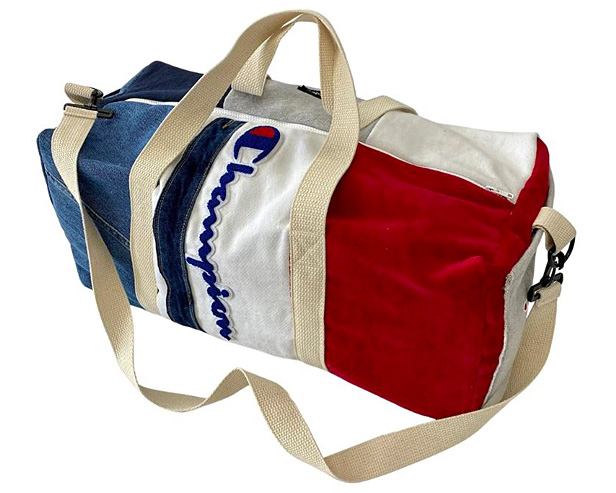Sustainability June 01, 2023
5 Smart Strategies for Repurposing Logoed Items
Consider these methods for breathing new life into obsolete promo products.
Deadstock. Misprints. Outdated logos. Overruns. Excess promo merchandise can cause challenges for industry professionals – no one wants their merchandise to end up in a landfill. But distributors and their clients are finding new ways to save old logoed products from the trash and create fresh looks to resuscitate used inventory. From prints to patches, being old is the trendy new. Here are five ingenious ideas to bring obsolete swag back to life.
1
Upcycle Products Into Something Unique

Refried Apparel transformed a “pretender” Champion hoodie into this one-of-a-kind duffle bag, as part of an upcycling collaboration with Champion.
Apparel and accessories no longer usable in their current form can become the building blocks for something new – whether that means mixing swatches of denim with a patch from an old sweatshirt or upcycling a single-use event banner into a keepsake tote.
Consider a recent collaboration between Champion, part of HanesBrands (asi/59528) and upcycling brand Refried Apparel. Champion invited consumers to swap thousands of “pretender” hoodies in exchange for new authentic Champion brand sweatshirts. To keep the post-consumer sweatshirts out of the landfill, Champion handed them over to Refried Apparel, which upcycled them into one-of-a-kind duffle bags, totes, bucket hats, scarves, pillows and more.
Mark Litos, co-founder of Refried, says his company specializes in such projects, taking surplus inventory and turning it into one-off items that offer individualized looks.
“Each piece is really unique because of the way we mix materials and do color blocking,” Litos adds. “We’ll receive pallets of goods, all different, which offers us more variety and more creativity.”
2
Consider Downcycling Old Items
When a misprinted or obsolete promo item isn’t a good candidate for donation or upcycling into a new item, there are still options to consider before resorting to a landfill. Downcycling, where waste is recycled into something of lower quality and functionality than the original material, is still a viable part of building a circular economy.
Used textiles can be turned into things like industrial wiping cloths, insulation materials or carpet pad fill, says Ben Grossman, co-president of Somerville, MA-based distributor Grossman Marketing Group (asi/215205) and creator of SwagCycle, an initiative that allows brands and other promo companies to recycle or repurpose unwanted promo items.
Another example: B Corp supplier Chameleon Like (asi/44558) runs old cardboard boxes through an industrial shredder to create a unique, eco-friendly packing filler.
These sorts of solutions are important, according to Grossman. “Landfill divergence is critical,” he explains. “When waste decomposes in landfills it releases methane gas, which is a very harmful greenhouse gas.”
3
Patch It Up

Kotis Design used detachable patches to give new life to a branded backpack, covering up a logo that was no longer relevant.
Patches are an innovative and stylish way to cover up old logos and reactivate a bag, jacket or other item. For example, Top 40 distributor Kotis Design (asi/244898) used this creative strategy to cover up a 4.5-inch logo on an existing backpack.
“We first sewed on a black strip of Velcro to cover the existing embroidery, then designed and produced two patches with Velcro backing to adhere to the bag,” says Nic Thomassen, chief creative officer at Kotis.
Using hook-and-loop to attach the patch gives the newly branded item even more longevity, since it can easily be rebranded with a different patch in the future, if necessary, according to Thomassen.
4
Try This Circular Screen-Printing Technology
Once a garment has been screen printed, traditionally there hasn’t been many options at the end of its useful life. Many charities don’t accept logoed tees, and companies that offer garment recycling typically have to cut out the print before shredding the fabric to turn it back into fiber.
But Swedish company Vividye has another solution: a textile print technology that actually makes a print removable without putting too much strain on the textile fiber. The company says it’s developed a pre-treatment that’s made to chemically respond to their removal solution. Pretreated shirts can be printed, “deprinted” then reprinted with a new design over and over again, which can prolong the lifetime of various garments. “We make printed fabrics part of the recycling loop, instead of part of endless landfills,” the company notes on its website.
5
Cover Old Artwork With a Block of Ink
For tees that haven’t received a special Vividye pretreatment, there’s another potential option to update the logo. Consider overlaying an existing logo with a solid black screen-printed background, then printing a new logo or branded message on top. This solution isn’t always workable or easy, cautions Thomassen. Often the best bet is to cover the ink completely and use that same shape as the basis for your new design, he says.
“Adding a white base or using black ink will help ensure the design underneath doesn’t show through, although it will make for a thicker print,” Thomassen adds.
The technique can be a great option for items like streetwear, concert tees and other trendy styles that lend themselves to blocky graphics.

Promo for the Planet is your destination for the latest news, biggest trends and best ideas to help build a more sustainable and socially-responsible industry.
